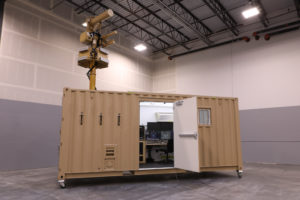
Colorado counter-drone firm Liteye Systems has won a $10 million contract to deliver its Anti-UAS Defense Systems (AUDS) to an unnamed U.S. government agency.
The contract is the latest of several deliveries of the systems to the U.S. military and other agencies spanning the last three years to the tune of $70 million.
AUDS deploys state-of-the-art radar, precision thermal and daylight cameras, advanced video tracking, and multiple non-kinetic defeat capabilities to neutralize hostile or errant drones. The company says AUDS has been used 1,000 times to defeat drones flown by ISIS and the Taliban overseas.
The Containerized AUDS variant the company sold features a streamlined operator suite. The solution is hardened for use in any climate and can easily be moved between locations.
“Liteye has AUDS operating all over the world,” Liteye CEO Kenneth Geyer said in a press release.
“As we’re seeing drone incidents escalate, it’s imperative that we’re more diligent about our technology improvements, on-time delivery and performance standards. We continue working with our end-users and partners to layer capabilities into the system to remain effective against the new threats recently seen in the news.”
Dubbed “the world’s first fully integrated detect-track-disrupt-defeat” drone defense system, AUDS took flight from a consortium that included Liteye, Gryphon Sensors and Sensofusion through an FAA Cooperative Research and Development Agreement.
Liteye unveiled AUDS in 2016 at the commercial UAV Expo in Las Vegas. The system has been described as “an anti-drone death ray, a drone zapper and a drone freezing ray, and it looks and sounds like something out of an early Flash Gordon episode.” The company also sealed a military deal in 2017 in partnership with IT/telecom provider Tribalco.
The military hopes the AUDS partnership can produce the similar results as the FAA’s Pathfinder Initiative. That plan addresses three areas of national drone integration – “visual line-of-sight operations in urban areas, extended visual line-of-sight operations in rural areas [and] beyond visual line-of-sight in rural/isolated areas.”
The exploding counter-drone industry could top almost $2 billion by 2024. As drone use grows, many public agencies and companies are seeking anti-drone solutions to stop drones from flying over restricted or unsafe locations such as wildfire zones, nuclear power plants, prisons and airports.
Jason is a longstanding contributor to DroneLife with an avid interest in all things tech. He focuses on anti-drone technologies and the public safety sector; police, fire, and search and rescue.
Beginning his career as a journalist in 1996, Jason has since written and edited thousands of engaging news articles, blog posts, press releases and online content.
Email Jason
TWITTER:@JasonPReagan
Subscribe to DroneLife here.







[…] Source link […]